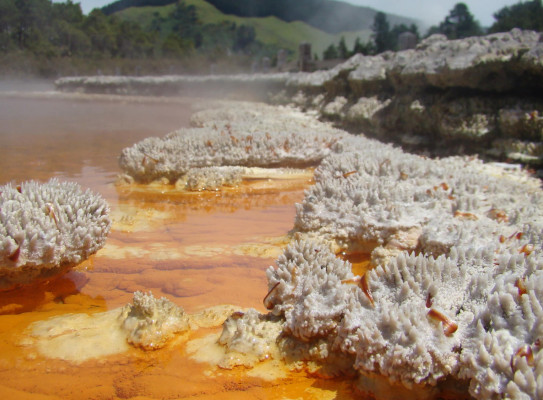Mineral systems

Mineral deposits in New Zealand occur in various geological environments, known as mineral systems.
A mineral system is a geological framework that explains how and where mineral deposits form. It considers key geological processes such as heat flow, fluid movement, and chemical reactions that concentrate minerals and elements into economically viable deposits. These systems form under specific geological processes, and their development into mines depends on various political, economic, social, environmental, and legal factors. For example, a large sandstone formation may initially contain only trace amounts of gold (the source of the critical mineral).
However, after being buried deep in the Earth's crust for millions of years, heat and pressure (a process known as metamorphism) generate hot fluids that extract and transport gold through the rock (the energy and fluid needed to mobilise the element). These mineral-rich fluids then migrate along pathways such as faults and fractures (transport pathways) before depositing gold within veins in structurally favourable locations (trap sites).
Mineral systems provide a valuable classification method for deposits that form through similar geological processes. In New Zealand, these systems can be grouped into four major geological process types: magmatic, hydrothermal, metamorphic, and sedimentary. Within these categories, sixteen distinct mineral systems describe how many of the country's mineral deposits have formed. Below are some of the mineral systems that describe our deposit forming processes:
Magmatic:
- Intrusion-related mineralisation (Au-W-Bi-Mo-Sn)
- Rare Earth Elements (REE)
- Ultramafic-mafic igneous Ni-Co-Cr and PGE (Pt, Pd, Os, It, Ru, Rh)
Hydrothermal:
- Epithermal gold (+ Ag, Cu, Hg) Taupo Volcanic Zone, Coromandel, and Northland
- Exhalative volcanic mineralisation (Au, Cu, Zn, Pb, Li) (i.e. our offshore marine mineralisation) (VMS)
- Porphyry
- Lithium – Pegmatite hosted
- Skarn and other base metal mineral deposits (Cu, Pb, Sn and Zn)

Sedimentary:
- Alluvial Au
- West Coast mineral sands (Ti, Zr, REE)
- Seafloor manganese (Mn) nodule and sediment mineral resources
- Clay and pozzolan minerals
- Lithium in hydrothermally altered lake sediments (HARSH model)
Metamorphic:
- Orogenic Au (+ W, Cu, Sb) – Otago / Marlborough
- Orogenic Au (+ W, Cu, Sb) – West Coast
- Silica & graphite

